Resolving Surface Heat Island Effects in Fine-Scale Spatio-Temporal Domains for the Two Warmest Metropolitan Cities of Korea
Highlights
- Sub-district-level heat intensification was quantified at the diurnal scale for the first time in Busan and Daegu, showing that high-resolution LST data captured much stronger surface urban heat island (SUHI) intensity than coarse-resolution data (up to 8 °C difference).
- Industrial areas exhibited the highest locational heat intensification (LHI), reaching 8 °C in Busan and 11 °C in Daegu, with rapid intensification rates of ~2 °C/h.
- The strong and rapid heat build-up in industrial and densely developed areas implies elevated health risks during summer daytime.
- Urban land use density substantially amplifies heat intensification, highlighting the importance of land use planning for urban climate adaptation.
Abstract
1. Introduction
2. Materials
2.1. Study Area
2.2. Satellite Data
2.2.1. ECOSTRESS
2.2.2. GK-2A
2.3. Ancillary Data
2.3.1. Land Use Data
2.3.2. Digital Elevation Model Data
3. Method
3.1. Quantification of Urban-Scale SUHI Intensity
3.2. Derivation of Diurnal SUHI Variation
3.3. Evaluation of LHI
3.4. Evaluation of the Land Use Density on the LHI
4. Results
4.1. Temporal Analysis of Urban Thermal Environment by Seasons
4.1.1. Diurnal Variation in SUHII at the Urban-Scale
4.1.2. Land-Use-Specific LST Analysis at Sub-District-Level
4.2. Analysis of Spatial Patterns and Density Effects on LHI
4.2.1. Sub-District-Level Spatial Patterns of LHI
4.2.2. Land-Use-Density-Dependent Variations in LHI
4.3. Comparison of SUHI and LHI Behavior Between the Two Cities
5. Discussion
5.1. On the Interpretation of Diurnal Variation Pattern
5.2. Improvement in the Estimation of Land-Use-Specific Heat Impact
5.3. LHI Behaviors of Industrial Areas
5.4. Limitation
6. Conclusions
Author Contributions
Funding
Data Availability Statement
Conflicts of Interest
Abbreviations
| UHI | Urban Heat Island |
| AUHI | Atmospheric Urban Heat Island |
| SUHI | Surface Urban Heat Island |
| LST | Land Surface Temperature |
| LHI | Locational Heat intensification |
| MODIS | Moderate Resolution Imaging Spectroradiometer |
| COMS | Communication, Oceanography, and Meteorology Satellite |
| ECOSTRESS | ECOsystem Spaceborne Thermal Radiometer Experiment on Space Station |
| GK-2A | Geostationary Korea Multi-Purpose Satellite-2A |
| RMSE | Root Mean Square Error |
| KST | Korean Standard Time |
| DEM | Digital Elevation model |
| SUHII | Surface Urban Heat Island Intensity |
| LID | Low Influence Development |
Appendix A
| Season | Hour | Date | Year | Season | Hour | Date | Year |
|---|---|---|---|---|---|---|---|
| Spring | 00:23:23 | 6 May | 2021 | Autumn | 01:29:50 | 19 November | 2022 |
| 02:34:11 | 21 March | 2020 | 01:52:38 | 21 September | 2020 | ||
| 03:15:59 | 19 May | 2020 | 03:06:48 | 15 November | 2022 | ||
| 03:49:04 | 17 March | 2021 | 03:35:09 | 15 November | 2021 | ||
| 05:21:32 | 13 March | 2021 | 04:01:00 | 15 November | 2020 | ||
| 06:24:58 | 11 May | 2020 | 04:43:18 | 11 November | 2022 | ||
| 07:22:01 | 19 April | 2021 | 05:35:36 | 11 November | 2020 | ||
| 08:20:46 | 4 May | 2022 | 06:19:21 | 7 November | 2022 | ||
| 09:52:27 | 12 April | 2022 | 06:26:37 | 7 September | 2022 | ||
| 10:40:51 | 9 April | 2022 | 06:54:00 | 20 October | 2020 | ||
| 10:50:16 | 29 April | 2021 | 07:44:30 | 16 October | 2022 | ||
| 13:09:06 | 22 April | 2022 | 08:44:21 | 3 November | 2020 | ||
| 15:06:47 | 29 May | 2021 | 09:21:29 | 12 October | 2022 | ||
| 15:28:44 | 17 April | 2021 | 09:30:20 | 30 October | 2022 | ||
| 16:13:22 | 25 May | 2022 | 10:02:47 | 12 October | 2020 | ||
| 17:01:17 | 13 April | 2021 | 12:40:24 | 22 October | 2022 | ||
| 17:26:34 | 24 May | 2021 | 13:21:10 | 1 October | 2022 | ||
| 18:48:19 | 7 April | 2022 | 15:04:23 | 15 October | 2022 | ||
| 22:50:59 | 9 May | 2021 | 16:40:26 | 11 October | 2022 | ||
| 23:12:21 | 27 May | 2021 | 17:46:14 | 22 September | 2020 | ||
| 21:28:22 | 12 November | 2020 | |||||
| Summer | 05:49:02 | 22 June | 2021 | Winter | 03:25:28 | 16 January | 2022 |
| 06:32:50 | 21 June | 2020 | 07:45:56 | 5 January | 2021 | ||
| 07:46:51 | 18 August | 2020 | 10:17:56 | 10 December | 2021 | ||
| 10:37:16 | 9 June | 2022 | 10:53:18 | 28 December | 2020 | ||
| 11:15:34 | 9 June | 2021 | 12:08:46 | 6 December | 2020 | ||
| 11:17:00 | 9 June | 2020 | 13:23:10 | 2 December | 2021 | ||
| 11:47:20 | 26 August | 2021 | 13:42:23 | 2 December | 2020 | ||
| 14:25:51 | 1 June | 2020 | 14:31:58 | 29 January | 2022 | ||
| 17:08:42 | 11 June | 2022 | 17:07:56 | 12 December | 2020 | ||
| 17:46:30 | 21 July | 2022 | 17:51:58 | 8 February | 2022 |
References
- Oke, T.R. The Urban Energy Balance. Prog. Phys. Geogr. 1988, 12, 471–508. [Google Scholar] [CrossRef]
- Oke, T.R.; Mills, G.; Christen, A.; Voogt, J.A. Urban Climates; Cambridge University Press: Cambridge, UK, 2017. [Google Scholar] [CrossRef]
- Lowe, S.A. An Energy and Mortality Impact Assessment of the Urban Heat Island in the US. Environ. Impact Assess. Rev. 2016, 56, 139–144. [Google Scholar] [CrossRef]
- Huang, W.T.K.; Masselot, P.; Bou-Zeid, E.; Fatichi, S.; Paschalis, A.; Sun, T.; Gasparrini, A.; Manoli, G. Economic Valuation of Temperature-Related Mortality Attributed to Urban Heat Islands in European Cities. Nat. Commun. 2023, 14, 7438. [Google Scholar] [CrossRef] [PubMed]
- Rivera, A.; Moore, N.; Kim, J.H.; Grady, S.C.; Bornstein, R.D. Evapotranspiration Impacts on Summer Surface Urban Heat Island Distributions and Trends in Santa Clara, California: Moderating Effects of the Human Environment. In Dry Urbanism: Designing for Drought in the City; Springer: Cham, Switzerland, 2025; pp. 235–259. [Google Scholar] [CrossRef]
- Wong, N.H.; Tan, C.L.; Kolokotsa, D.D.; Takebayashi, H. Greenery as a Mitigation and Adaptation Strategy to Urban Heat. Nat. Rev. Earth Environ. 2021, 2, 166–181. [Google Scholar] [CrossRef]
- Mentaschi, L.; Duveiller, G.; Zulian, G.; Corbane, C.; Pesaresi, M.; Maes, J.; Stocchino, A.; Feyen, L. Global Long-Term Mapping of Surface Temperature Shows Intensified Intra-City Urban Heat Island Extremes. Glob. Environ. Change 2022, 72, 102441. [Google Scholar] [CrossRef]
- Oke, T.R. The Distinction between Canopy and Boundary-Layer Urban Heat Islands. Atmosphere 1976, 14, 268–277. [Google Scholar] [CrossRef]
- Voogt, J.A.; Oke, T.R. Thermal Remote Sensing of Urban Climates. Remote Sens. Environ. 2003, 86, 370–384. [Google Scholar] [CrossRef]
- Zhou, D.; Xiao, J.; Bonafoni, S.; Berger, C.; Deilami, K.; Zhou, Y.; Frolking, S.; Yao, R.; Qiao, Z.; Sobrino, J.A. Satellite Remote Sensing of Surface Urban Heat Islands: Progress, Challenges, and Perspectives. Remote Sens. 2018, 11, 48. [Google Scholar] [CrossRef]
- Piracha, A.; Chaudhary, M.T. Urban Air Pollution, Urban Heat Island and Human Health: A Review of the Literature. Sustainability 2022, 14, 9234. [Google Scholar] [CrossRef]
- Gerçek, D.; Güven, İ.T. Assessment of Mutual Variation of Near-Surface Air Temperature, Land Surface Temperature and Driving Urban Parameters at Urban Microscale. Sustainability 2023, 15, 15710. [Google Scholar] [CrossRef]
- Eliasson, I. Urban Geometry, Surface Temperature and Air Temperature. Energy Build. 1990, 15, 141–145. [Google Scholar] [CrossRef]
- Peng, S.; Piao, S.; Ciais, P.; Friedlingstein, P.; Ottle, C.; Bréon, F.-M.; Nan, H.; Zhou, L.; Myneni, R.B. Surface Urban Heat Island across 419 Global Big Cities. Environ. Sci. Technol. 2012, 46, 696–703. [Google Scholar] [CrossRef] [PubMed]
- Venter, Z.S.; Chakraborty, T.; Lee, X. Crowdsourced Air Temperatures Contrast Satellite Measures of the Urban Heat Island and Its Mechanisms. Sci. Adv. 2021, 7, eabb9569. [Google Scholar] [CrossRef] [PubMed]
- Patz, J.A.; Campbell-Lendrum, D.; Holloway, T.; Foley, J.A. Impact of Regional Climate Change on Human Health. Nature 2005, 438, 310–317. [Google Scholar] [CrossRef]
- Santamouris, M.; Cartalis, C.; Synnefa, A.; Kolokotsa, D. On the Impact of Urban Heat Island and Global Warming on the Power Demand and Electricity Consumption of Buildings—A Review. Energy Build. 2015, 98, 119–124. [Google Scholar] [CrossRef]
- Weng, Q. Thermal Infrared Remote Sensing for Urban Climate and Environmental Studies: Methods, Applications, and Trends. ISPRS J. Photogramm. Remote Sens. 2009, 64, 335–344. [Google Scholar] [CrossRef]
- Deilami, K.; Kamruzzaman, M.; Liu, Y. Urban Heat Island Effect: A Systematic Review of Spatio-Temporal Factors, Data, Methods, and Mitigation Measures. Int. J. Appl. Earth Obs. Geoinf. 2018, 67, 30–42. [Google Scholar] [CrossRef]
- Oke, T.R. The Energetic Basis of the Urban Heat Island. Q. J. R. Meteorol. Soc. 1982, 108, 1–24. [Google Scholar] [CrossRef]
- Sobrino, J.A.; Oltra-Carrió, R.; Sòria, G.; Bianchi, R.; Paganini, M. Impact of Spatial Resolution and Satellite Overpass Time on Evaluation of the Surface Urban Heat Island Effects. Remote Sens. Environ. 2012, 117, 50–56. [Google Scholar] [CrossRef]
- Usmani, B.A.; Ahmed, M.; Waqar, T.; Allana, A.; Ahmed, Z.; Fatmi, Z. Microscale Urban Heat Variability and Time-Location Patterns: Elevated Exposure for Bikers and Rickshaw Drivers beyond Average City Temperatures in Megacity. Urban Clim. 2024, 58, 102177. [Google Scholar] [CrossRef]
- Golden, J.S.; Kaloush, K.E. Mesoscale and Microscale Evaluation of Surface Pavement Impacts on the Urban Heat Island Effects. Int. J. Pavement Eng. 2006, 7, 37–52. [Google Scholar] [CrossRef]
- Mohajerani, A.; Bakaric, J.; Jeffrey-Bailey, T. The Urban Heat Island Effect, Its Causes, and Mitigation, with Reference to the Thermal Properties of Asphalt Concrete. J. Environ. Manag. 2017, 197, 522–538. [Google Scholar] [CrossRef] [PubMed]
- Kim, K.J.; Yeo, I.A.; Yoon, S. The Quantitative Analysis on the Possibilities of Extreme Heat and Tropical Night in Main Cities. In Proceedings of the Korean Institute of Architectural Sustainable Environment and Building Systems Conference, Seoul, Republic of Korea, 25 March 2011; pp. 107–110. [Google Scholar]
- Kim, E.B.; Park, J.K.; Jung, W.S. A Study on the Occurrence Characteristics of Tropical Night Day and Extreme Heat Day in the Metropolitan City, Korea. J. Environ. Sci. Int. 2014, 23, 873–885. [Google Scholar] [CrossRef]
- Korea Disease Control and Prevention Agency. Yearbook of Heat-Related Illnesses Reported due to Heatwaves; Ministry of Health and Welfare: Sejong, Republic of Korea, 2023; Available online: https://kdca.go.kr/ (accessed on 11 September 2025).
- Seong, J.H.; Lee, K.R.; Kwon, Y.S.; Han, Y.K.; Lee, W.H. A Study on Identification of the Heat Vulnerability Area Considering Spatial Autocorrelation—Case Study in Daegu. J. Korean Soc. Surv. Geod. Photogramm. Cartogr. 2020, 38, 295–304. [Google Scholar] [CrossRef]
- Lee, Y.; Lee, S.; Im, J.; Yoo, C. Analysis of Surface Urban Heat Island and Land Surface Temperature Using Deep Learning-Based Local Climate Zone Classification: A Case Study of Suwon and Daegu, Korea. Korean J. Remote Sens. 2021, 37, 1447–1460. [Google Scholar] [CrossRef]
- Bechtel, B.; Demuzere, M.; Mills, G.; Zhan, W.; Sismanidis, P.; Small, C.; Voogt, J. SUHI Analysis Using Local Climate Zones—A Comparison of 50 Cities. Urban Clim. 2019, 28, 100451. [Google Scholar] [CrossRef]
- Moon, J.H.; Park, S.Y.; Lee, S.H. Comparative Study of Spatiotemporal Variation in the Urban Heat Island Core in Coastal and Inland Basin Cities. Air Qual. Atmos. Health 2022, 15, 1439–1451. [Google Scholar] [CrossRef]
- Streutker, D.R. Satellite-Measured Growth of the Urban Heat Island of Houston, Texas. Remote Sens. Environ. 2003, 85, 282–289. [Google Scholar] [CrossRef]
- Zakšek, K.; Oštir, K. Downscaling Land Surface Temperature for Urban Heat Island Diurnal Cycle Analysis. Remote Sens. Environ. 2012, 117, 114–124. [Google Scholar] [CrossRef]
- Chang, Y.; Xiao, J.; Li, X.; Frolking, S.; Zhou, D.; Schneider, A.; Weng, Q.; Yu, P.; Wang, X.; Li, X.; et al. Exploring Diurnal Cycles of Surface Urban Heat Island Intensity in Boston with Land Surface Temperature Data Derived from GOES-R Geostationary Satellites. Sci. Total Environ. 2021, 763, 144224. [Google Scholar] [CrossRef]
- Gao, F.; Kustas, W.P.; Anderson, M.C. A Data Mining Approach for Sharpening Thermal Satellite Imagery over Land. Remote Sens. 2012, 4, 3287–3319. [Google Scholar] [CrossRef]
- Bisquert, M.; Sánchez, J.M.; Caselles, V. Evaluation of Disaggregation Methods for Downscaling MODIS Land Surface Temperature to Landsat Spatial Resolution in Barrax Test Site. IEEE J. Sel. Top. Appl. Earth Obs. Remote Sens. 2016, 9, 1430–1438. [Google Scholar] [CrossRef]
- Hutengs, C.; Vohland, M. Downscaling Land Surface Temperatures at Regional Scales with Random Forest Regression. Remote Sens. Environ. 2016, 178, 127–141. [Google Scholar] [CrossRef]
- Yang, Y.; Cao, C.; Pan, X.; Li, X.; Zhu, X. Downscaling Land Surface Temperature in an Arid Area by Using Multiple Remote Sensing Indices with Random Forest Regression. Remote Sens. 2017, 9, 789. [Google Scholar] [CrossRef]
- Essa, W.; Verbeiren, B.; Van der Kwast, J.; Batelaan, O. Improved DisTrad for Downscaling Thermal MODIS Imagery over Urban Areas. Remote Sens. 2017, 9, 1243. [Google Scholar] [CrossRef]
- Li, X.; Foody, G.M.; Boyd, D.S.; Ge, Y.; Zhang, Y.; Du, Y.; Ling, F. SFSDAF: An Enhanced FSDAF That Incorporates Sub-Pixel Class Fraction Change Information for Spatio-Temporal Image Fusion. Remote Sens. Environ. 2020, 237, 111537. [Google Scholar] [CrossRef]
- Deng, F.; Yang, Y.; Zhao, E.; Xu, N.; Li, Z.; Zheng, P.; Han, Y.; Gong, J. Urban Heat Island Intensity Changes in Guangdong-Hong Kong-Macao Greater Bay Area of China Revealed by Downscaling MODIS LST with Deep Learning. Int. J. Environ. Res. Public Health 2022, 19, 17001. [Google Scholar] [CrossRef]
- Yoo, C.; Im, J.; Park, S.; Cho, D. Spatial Downscaling of MODIS Land Surface Temperature: Recent Research Trends, Challenges, and Future Directions. Korean J. Remote Sens. 2020, 36, 609–626. [Google Scholar] [CrossRef]
- Wei, L.; Sobrino, J.A. Surface Urban Heat Island Analysis Based on Local Climate Zones Using ECOSTRESS and Landsat Data: A Case Study of Valencia City (Spain). Int. J. Appl. Earth Obs. Geoinf. 2024, 130, 103875. [Google Scholar] [CrossRef]
- Wang, J.; Cui, X.; Zhao, F.; Huang, M.; Guo, Y.; Wang, Q.; Tong, Y. ECOSTRESS-Based Analysis of Diurnal Urban Heat Island Intensity and Thermal Dynamics Across LCZ in Six Chinese Cities with Diverse Terrain and Elevation. IEEE J. Sel. Top. Appl. Earth Obs. Remote Sens. 2025, 18, 1–12. [Google Scholar] [CrossRef]
- Chang, Y.; Xiao, J.; Li, X.; Weng, Q. Monitoring Diurnal Dynamics of Surface Urban Heat Island for Urban Agglomerations Using ECOSTRESS Land Surface Temperature Observations. Sustain. Cities Soc. 2023, 98, 104833. [Google Scholar] [CrossRef]
- Chang, Y.; Xiao, J.; Li, X.; Middel, A.; Zhang, Y.; Gu, Z.; Wu, Y.; He, S. Exploring Diurnal Thermal Variations in Urban Local Climate Zones with ECOSTRESS Land Surface Temperature Data. Remote Sens. Environ. 2021, 263, 112544. [Google Scholar] [CrossRef]
- Busan Metropolitan City. The 62th Busan Statistical Yearbook; Busan Metropolitan City: Busan, Republic of Korea, 2024. [Google Scholar]
- Korea Meteorological Administration. Annual Climatological Report (2022); Korea Meteorological Administration: Seoul, Republic of Korea, 2022; Available online: https://data.kma.go.kr/ (accessed on 11 September 2025).
- Statistics Korea. 2023 Elderly Statistics; Statistics Korea: Daejeon, Republic of Korea, 2023; Available online: http://kostat.go.kr/ (accessed on 11 September 2025).
- Daegu Metropolitan City. Daegu Statistical Yearbook, 63rd Edition 2023; Daegu Metropolitan City: Daegu, Republic of Korea, 2024. [Google Scholar]
- National Institute of Meteorological Sciences. Climate Change in the Korean Peninsula over 100 Years; Climate Research Department, NIMS: Jeju, Republic of Korea, 2018; Available online: http://www.nims.go.kr/ (accessed on 11 September 2025).
- Hulley, G.C.; Gottsche, F.M.; Rivera, G.; Hook, S.J.; Freepartner, R.J.; Martin, M.A.; Cawse-Nicholson, K.; Johnson, W.R. Validation and Quality Assessment of the ECOSTRESS Level-2 Land Surface Temperature and Emissivity Product. IEEE Trans. Geosci. Remote Sens. 2021, 60, 1–23. [Google Scholar] [CrossRef]
- Choi, Y.Y.; Suh, M.S. Development of a Land Surface Temperature Retrieval Algorithm from GK2A/AMI. Remote Sens. 2020, 12, 3050. [Google Scholar] [CrossRef]
- Ministry of Environment, Republic of Korea. Guidelines for Land-Cover Map Construction; MoE Ordinance No. 1577, 19 December 2022; Ministry of Environment: Sejong, Republic of Korea, 2022. (In Korean) [Google Scholar]
- Jusuf, S.K.; Wong, N.H.; Hagen, E.; Anggoro, R.; Hong, Y. The Influence of Land Use on the Urban Heat Island in Singapore. Habitat Int. 2007, 31, 232–242. [Google Scholar] [CrossRef]
- Keeratikasikorn, C.; Bonafoni, S. Urban Heat Island Analysis over the Land Use Zoning Plan of Bangkok by Means of Landsat 8 Imagery. Remote Sens. 2018, 10, 440. [Google Scholar] [CrossRef]
- Schneider, A.; Friedl, M.A.; Potere, D. A New Map of Global Urban Extent from MODIS Satellite Data. Environ. Res. Lett. 2009, 4, 044003. [Google Scholar] [CrossRef]
- Schneider, A.; Friedl, M.A.; Potere, D. Mapping Global Urban Areas Using MODIS 500-m Data: New Methods and Datasets Based on ‘Urban Ecoregions’. Remote Sens. Environ. 2010, 114, 1733–1746. [Google Scholar] [CrossRef]
- Schneider, A.; Friedl, M.A.; McIver, D.K.; Woodcock, C.E. Mapping Urban Areas by Fusing Multiple Sources of Coarse Resolution Remotely Sensed Data. Photogramm. Eng. Remote Sens. 2003, 69, 1377–1386. [Google Scholar] [CrossRef]
- Chang, Y.; Xiao, J.; Li, X.; Zhou, D.; Wu, Y. Combining GOES-R and ECOSTRESS Land Surface Temperature Data to Investigate Diurnal Variations of Surface Urban Heat Island. Sci. Total Environ. 2022, 823, 153652. [Google Scholar] [CrossRef]
- Lai, J.; Zhan, W.; Huang, F.; Voogt, J.; Bechtel, B.; Allen, M.; Peng, S.; Hong, F.; Liu, Y.; Du, P. Identification of Typical Diurnal Patterns for Clear-Sky Climatology of Surface Urban Heat Islands. Remote Sens. Environ. 2018, 217, 203–220. [Google Scholar] [CrossRef]
- Mathew, A.; Khandelwal, S.; Kaul, N. Analysis of Diurnal Surface Temperature Variations for the Assessment of Surface Urban Heat Island Effect over Indian Cities. Energy Build. 2018, 159, 271–295. [Google Scholar] [CrossRef]
- Mathew, A.; Khandelwal, S.; Kaul, N.; Chauhan, S. Analyzing the Diurnal Variations of Land Surface Temperatures for Surface Urban Heat Island Studies: Is Time of Observation of Remote Sensing Data Important? Sustain. Cities Soc. 2018, 40, 194–213. [Google Scholar] [CrossRef]
- Athukorala, D.; Murayama, Y. Urban Heat Island Formation in Greater Cairo: Spatio-Temporal Analysis of Daytime and Nighttime Land Surface Temperatures along the Urban–Rural Gradient. Remote Sens. 2021, 13, 1396. [Google Scholar] [CrossRef]
- Siddiqui, A.; Kushwaha, G.; Nikam, B.; Srivastav, S.K.; Shelar, A.; Kumar, P. Analysing the Day/Night Seasonal and Annual Changes and Trends in Land Surface Temperature and Surface Urban Heat Island Intensity (SUHII) for Indian Cities. Sustain. Cities Soc. 2021, 75, 103374. [Google Scholar] [CrossRef]
- Cao, S.; Cai, Y.; Du, M.; Weng, Q.; Lu, L. Seasonal and Diurnal Surface Urban Heat Islands in China: An Investigation of Driving Factors with Three-Dimensional Urban Morphological Parameters. GISci. Remote Sens. 2022, 59, 1121–1142. [Google Scholar] [CrossRef]
- Hu, L.; Brunsell, N.A. The Impact of Temporal Aggregation of Land Surface Temperature Data for Surface Urban Heat Island (SUHI) Monitoring. Remote Sens. Environ. 2013, 134, 162–174. [Google Scholar] [CrossRef]
- Rowland, S.T.; Chillrud, L.G.; Boehme, A.K.; Wilson, A.; Rush, J.; Just, A.C.; Kioumourtzoglou, M.A. Can Weather Help Explain ‘Why Now?’: The Potential Role of Hourly Temperature as a Stroke Trigger. Environ. Res. 2022, 207, 112229. [Google Scholar] [CrossRef]
- Bhaskaran, K.; Armstrong, B.; Hajat, S.; Haines, A.; Wilkinson, P.; Smeeth, L. Heat and Risk of Myocardial Infarction: Hourly Level Case-Crossover Analysis of MINAP Database. BMJ 2012, 345, e8050. [Google Scholar] [CrossRef]
- Lee, Y.; Lee, K.; Park, S. Analysis of Hotspot Changes in Daegu Metropolitan City in Summer Using Landsat 8 Satellite Images. Korean J. Remote Sens. 2024, 40, 1379–1389. [Google Scholar] [CrossRef]
- Kim, S.; Lim, Y.; Cheon, S.H. Monitoring the Impact of Urban Development in Magok on Surface Urban Heat Island Intensity. Korean J. Remote Sens. 2025, 41, 153–172. [Google Scholar] [CrossRef]
- Zhou, Y.; Zhao, H.; Mao, S.; Zhang, G.; Jin, Y.; Luo, Y.; Huo, W.; Pan, Z.; An, P.; Lun, F. Exploring Surface Urban Heat Island (SUHI) Intensity and Its Implications Based on Urban 3D Neighborhood Metrics: An Investigation of 57 Chinese Cities. Sci. Total Environ. 2022, 847, 157662. [Google Scholar] [CrossRef]
- Meng, Q.; Hu, D.; Zhang, Y.; Chen, X.; Zhang, L.; Wang, Z. Do Industrial Parks Generate Intra-Heat Island Effects in Cities? New Evidence, Quantitative Methods, and Contributing Factors from a Spatiotemporal Analysis of Top Steel Plants in China. Environ. Pollut. 2022, 292, 118383. [Google Scholar] [CrossRef]
- Rahmani, N.; Sharifi, A. Comparative Analysis of the Surface Urban Heat Island (SUHI) Effect Based on the Local Climate Zone (LCZ) Classification Scheme for Two Japanese Cities, Hiroshima, and Sapporo. Climate 2023, 11, 142. [Google Scholar] [CrossRef]
- Feinberg, A. Global Warming Due to Albedo & Hydro-Hotspots Humidity Forcing Conflicts with CO2 Theory and A Lack of IPCC Albedo Goals. viXra 2020. Available online: https://vixra.org/abs/1910.0002 (accessed on 11 September 2025).
- Andrés-Anaya, P.; Sánchez-Aparicio, M.; del Pozo, S.; Lagüela, S. Correlation of Land Surface Temperature with IR Albedo for the Analysis of Urban Heat Island. Eng. Proc. 2021, 8, 9. [Google Scholar] [CrossRef]
- Lee, S.H.; Ahn, J.S.; Kim, S.W.; Kim, H.D. Multiple Albedo Variation Caused by the Shadow Effect of Urban Building and Its Impacts on the Urban Surface Heat Budget. J. Korean Earth Sci. Soc. 2010, 31, 738–748. [Google Scholar] [CrossRef]
- Shuman, E.C. Field Measurements of Heat Flow through a Roof with Saturated Thermal Insulation and Covered with Black and White Granules. In Thermal Insulation Performance; ASTM International: West Conshohocken, PA, USA, 1980. [Google Scholar] [CrossRef]
- Saha, B.K.; Chakraborty, B.; Dutta, R. Estimation of Waste Heat and Its Recovery Potential from Energy-Intensive Industries. Clean Technol. Environ. Policy 2020, 22, 1795–1814. [Google Scholar] [CrossRef]
- Liu, S.; Zhang, J.; Wang, K.; Wu, X.; Chen, W.; Liang, S.; Zhang, Y.; Fu, S. Structural Indicator Synergy for Mitigating Extreme Urban Heat Island Effects in Industrial City: Simulation and Verification Based on Machine Learning. Ecol. Indic. 2023, 157, 111216. [Google Scholar] [CrossRef]
- Jouhara, H.; Khordehgah, N.; Almahmoud, S.; Delpech, B.; Chauhan, A.; Tassou, S.A. Waste Heat Recovery Technologies and Applications. Therm. Sci. Eng. Prog. 2018, 6, 268–289. [Google Scholar] [CrossRef]
- Brough, D.; Jouhara, H. The Aluminium Industry: A Review on State-of-the-Art Technologies, Environmental Impacts and Possibilities for Waste Heat Recovery. Int. J. Thermofluids 2020, 1, 100007. [Google Scholar] [CrossRef]
- Royo, P.; Acevedo, L.; Arnal, Á.J.; Diaz-Ramírez, M.; García-Armingol, T.; Ferreira, V.J.; Ferreira, G.; López-Sabirón, A.M. Decision Support System of Innovative High-Temperature Latent Heat Storage for Waste Heat Recovery in the Energy-Intensive Industry. Energies 2021, 14, 365. [Google Scholar] [CrossRef]
- Zhang, L.; Meng, Q.; Sun, Z.; Sun, Y. Spatial and Temporal Analysis of the Mitigating Effects of Industrial Relocation on the Surface Urban Heat Island over China. ISPRS Int. J. Geo-Inf. 2017, 6, 121. [Google Scholar] [CrossRef]
- Kim, Y.; Lee, S.; Cho, D.; Im, J. Impact of COVID-19 on the Urban Heat Island in Daegu Using Downscaled Land Surface Temperature. Korean J. Remote Sens. 2024, 40, 1109–1125. [Google Scholar] [CrossRef]
- Energy Greenhouse Gas Total Information Platform Service. Statistics on Industrial Power Consumption Load Patterns in South Korea; Ministry of Trade, Industry and Energy: Sejong, Republic of Korea, 2021; Available online: https://www.gir.go.kr/ (accessed on 11 September 2025).
- McGarity, A.; Hung, F.; Rosan, C.; Hobbs, B.; Heckert, M.; Szalay, S. Quantifying Benefits of Green Stormwater Infrastructure in Philadelphia. In World Environmental and Water Resources Congress 2015; American Society of Civil Engineers: Reston, VA, USA, 2015; pp. 409–420. [Google Scholar] [CrossRef]
- Lang, S.; Rothenberg, J. Neoliberal Urbanism, Public Space, and the Greening of the Growth Machine: New York City’s High Line Park. Environ. Plan. A Econ. Space 2017, 49, 1743–1761. [Google Scholar] [CrossRef]
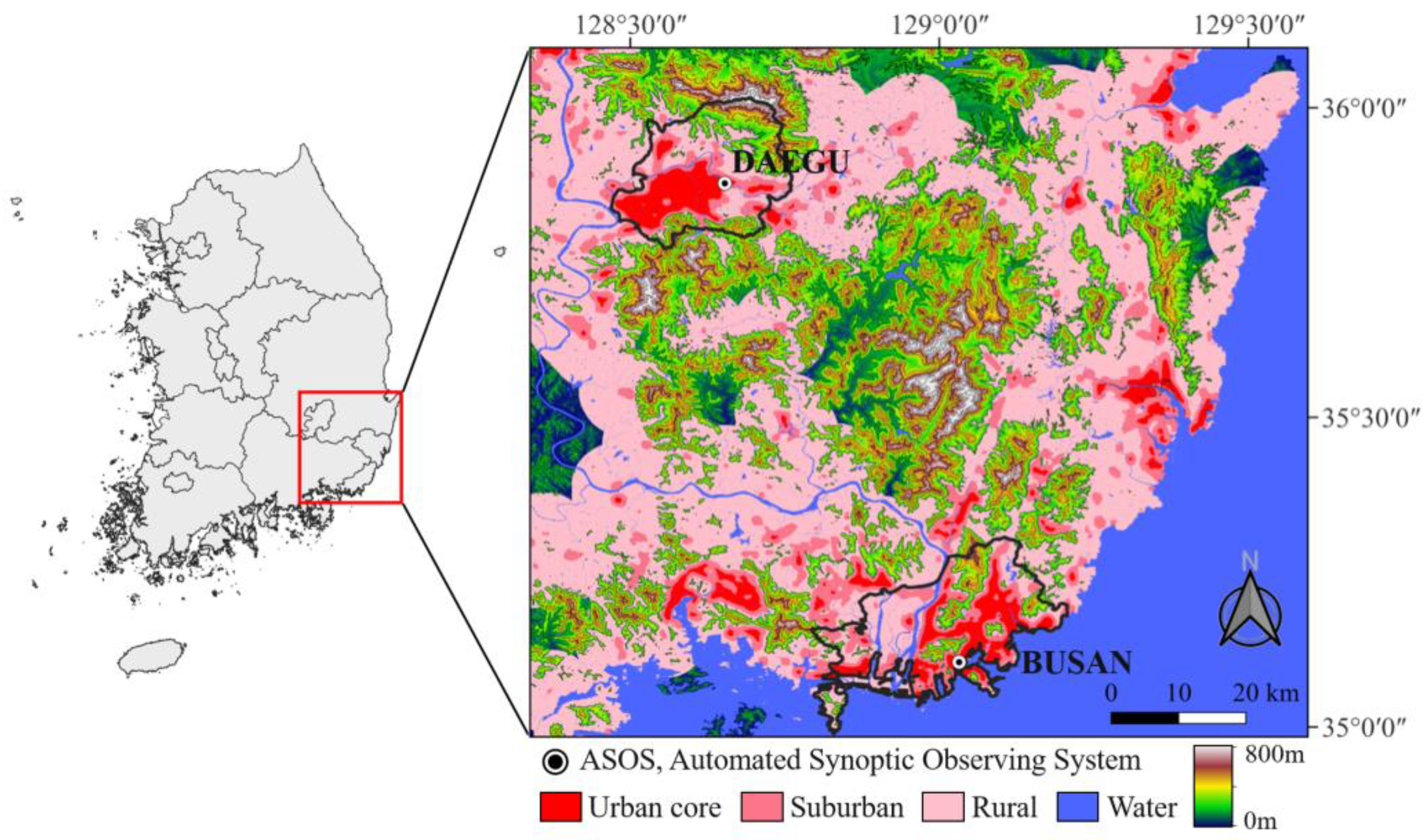
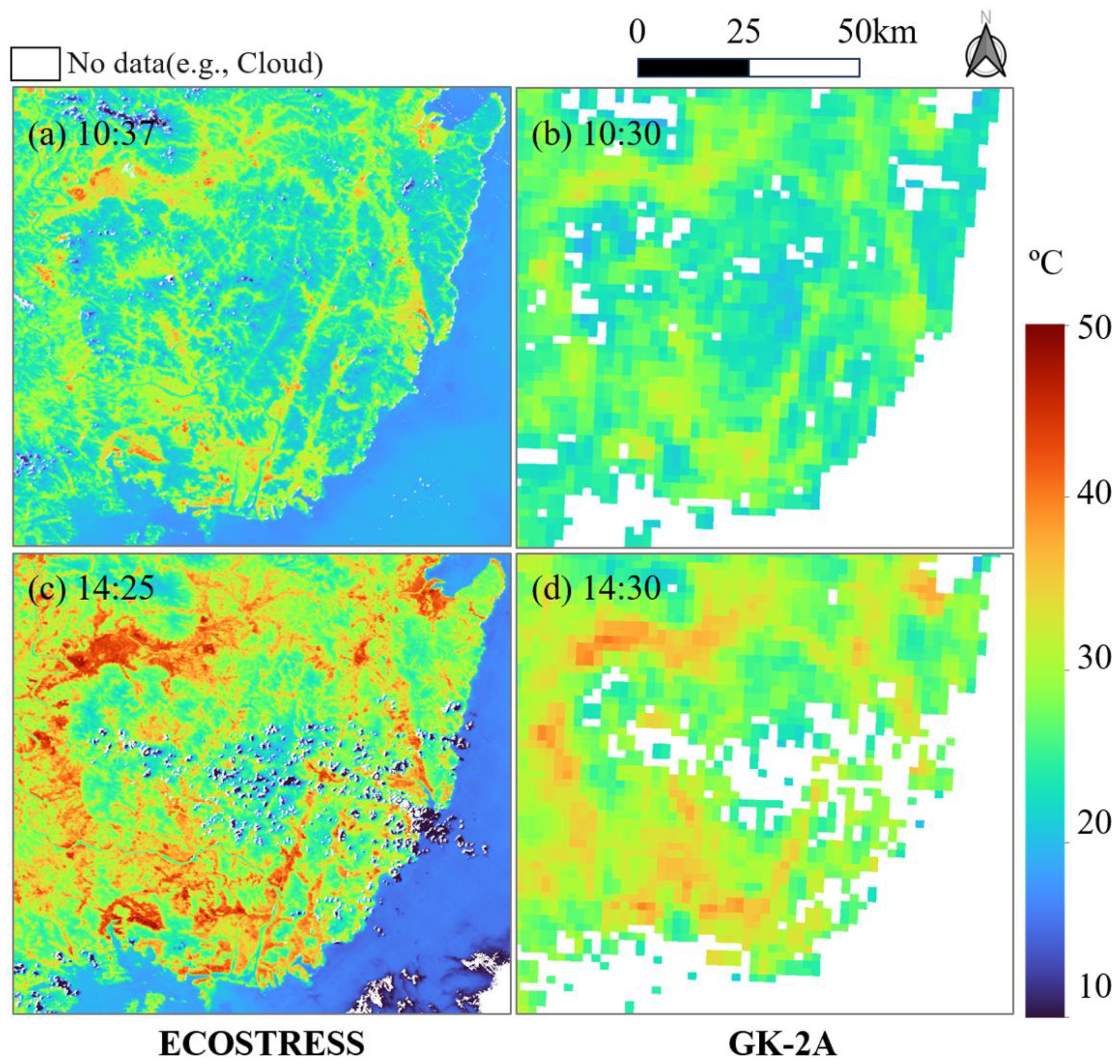

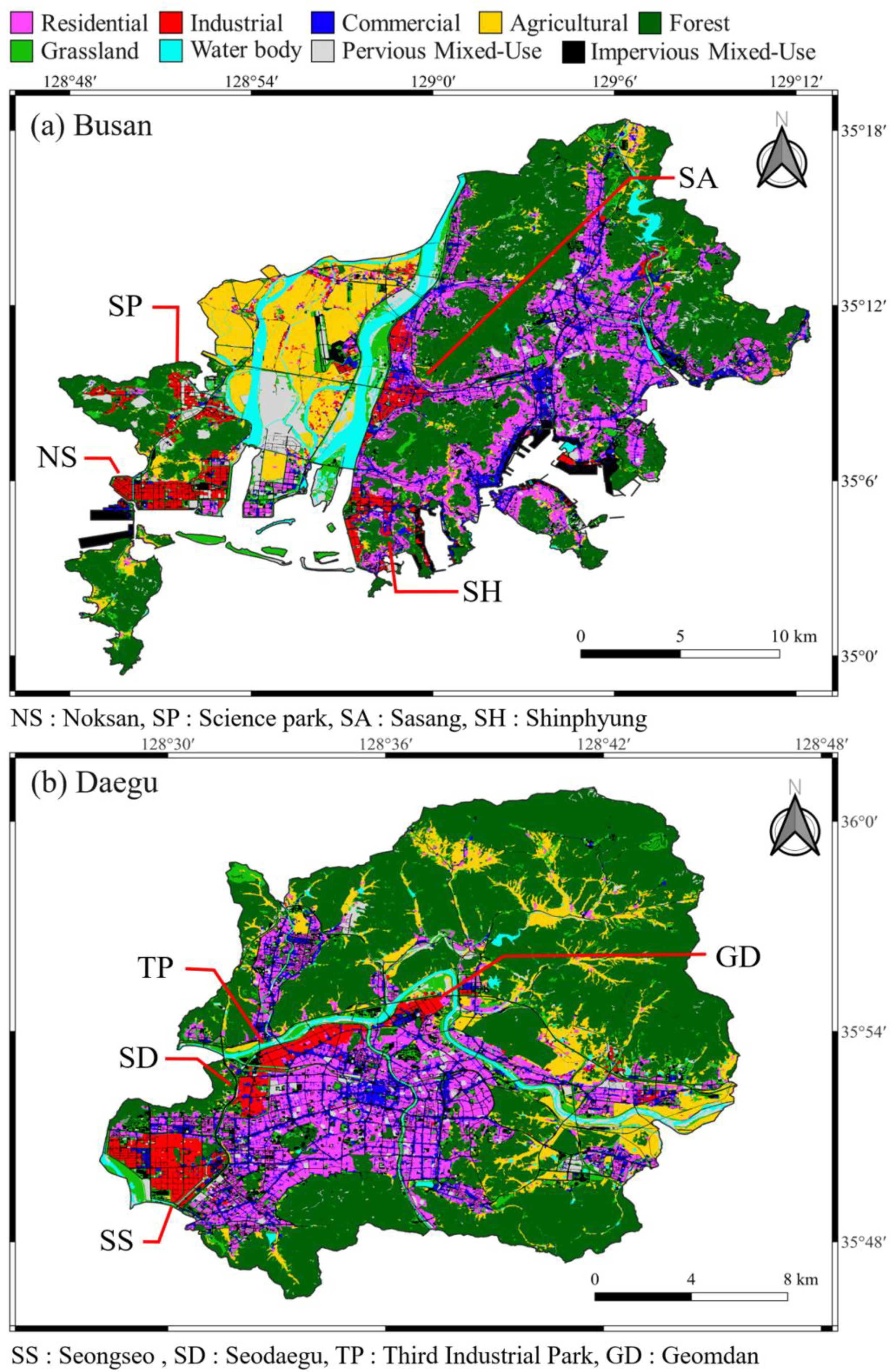
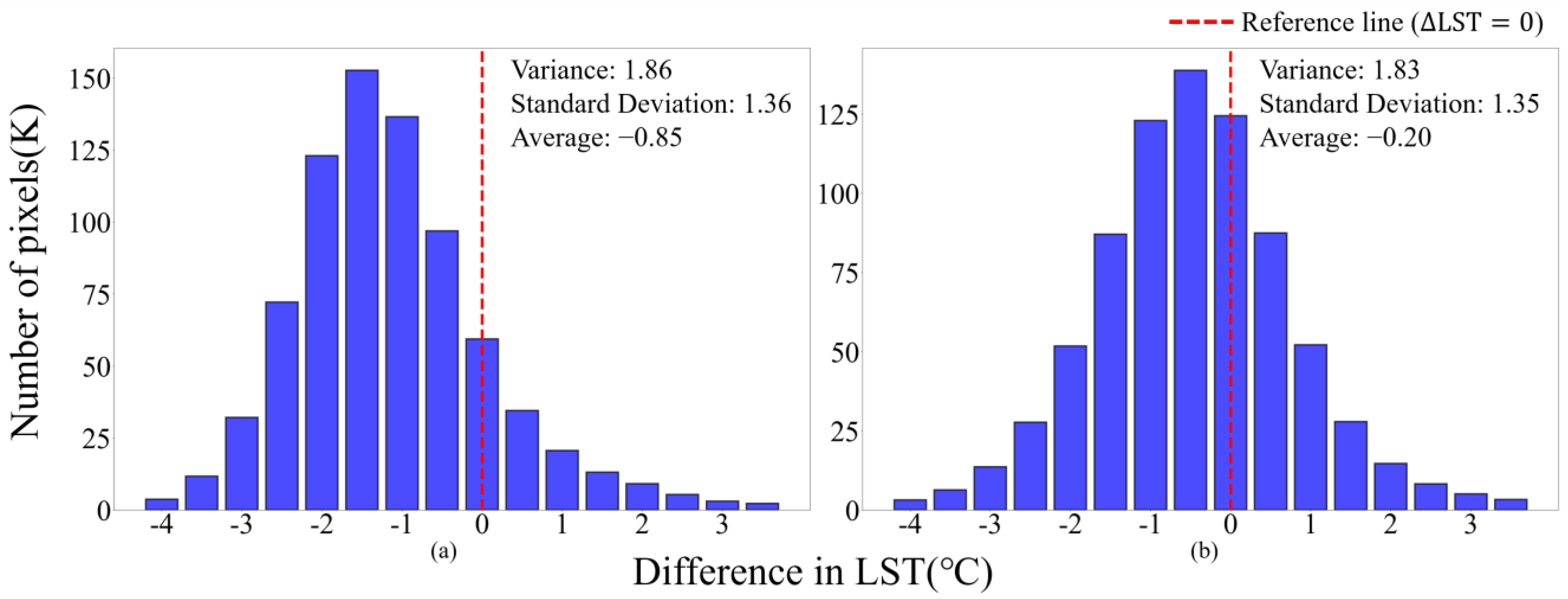




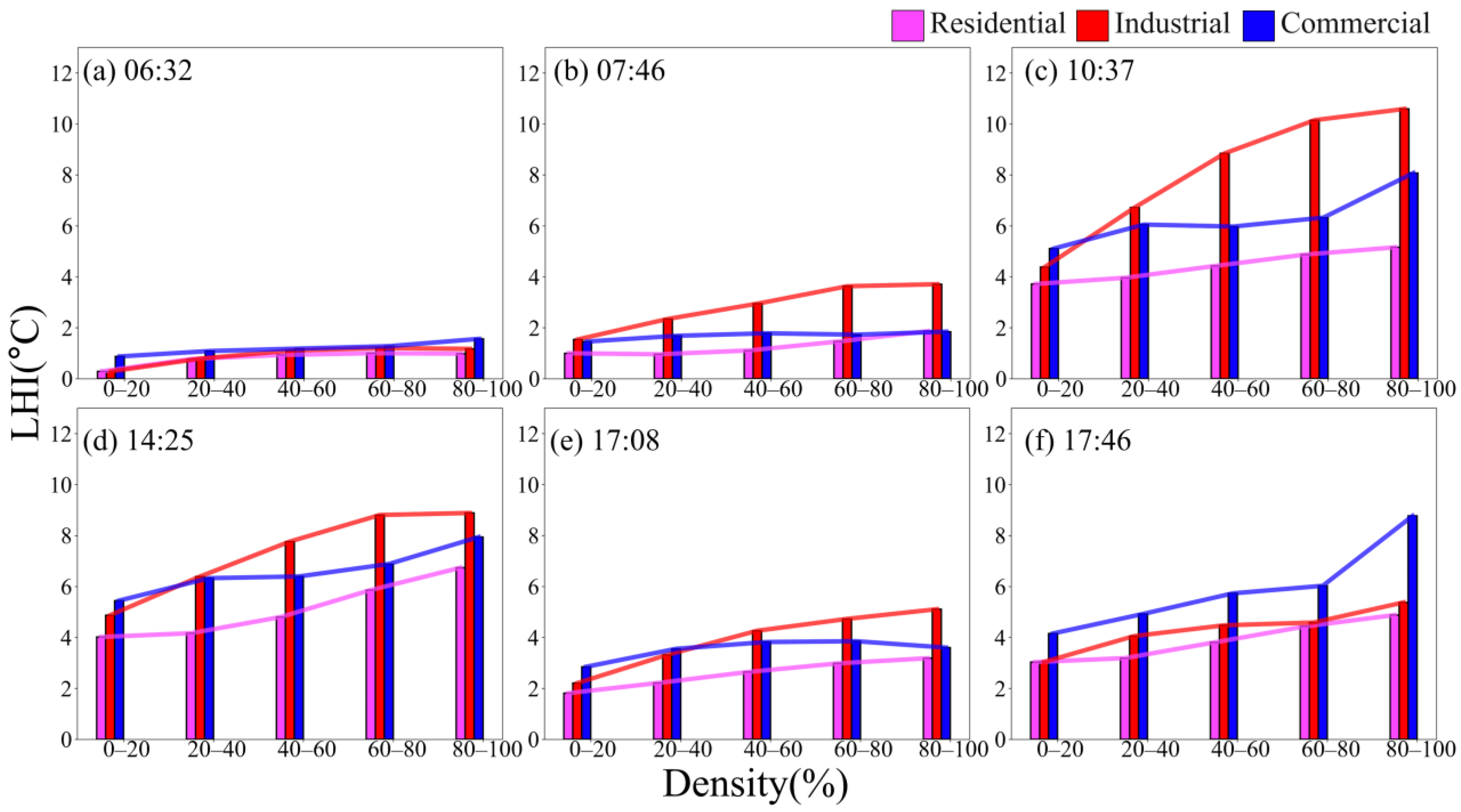
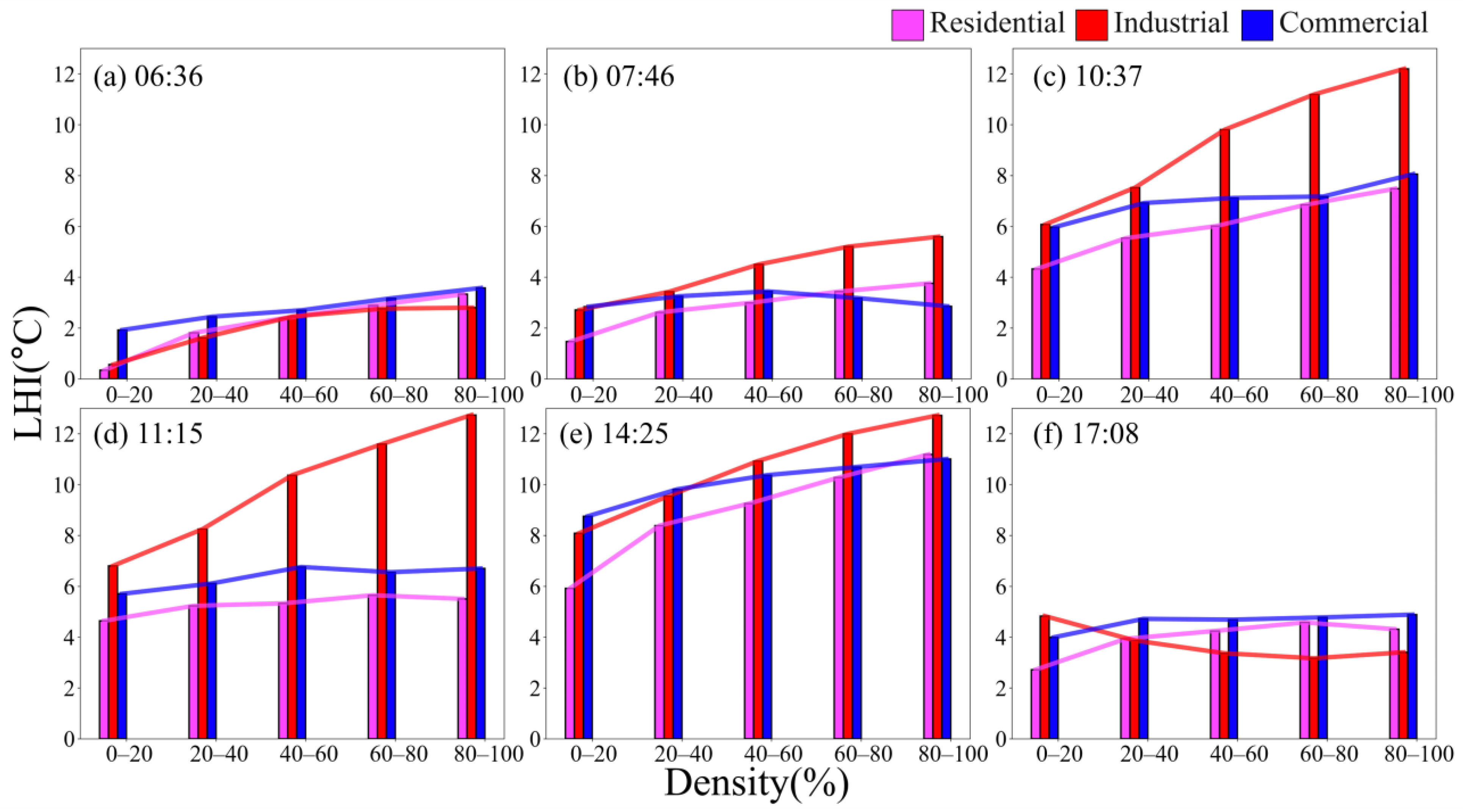
| Level | Hight-Level | Middle-Level |
|---|---|---|
| Types | Built Area | Residential Area |
| Industrial Area | ||
| Commercial Area | ||
| Agricultural Land | ||
| Forest | ||
| Grass | ||
| Land Use Types | LST (°C) | |||||
|---|---|---|---|---|---|---|
| Busan | Daegu | |||||
| ECO | GK2A | Diff | ECO | GK2A | Diff | |
| Residential Area | 40.36 | 33.03 | 7.33 | 45.08 | 36.41 | 8.66 |
| Industrial Area | 42.55 | 33.44 | 9.10 | 47.30 | 39.15 | 8.15 |
| Commercial Area | 41.35 | 33.21 | 8.15 | 45.37 | 36.92 | 8.46 |
| Agricultural Area | 37.63 | 33.97 | 3.66 | 38.66 | 34.08 | 4.58 |
| Forest | 30.97 | 31.77 | −0.80 | 32.71 | 32.47 | 0.24 |
| Grass | 37.18 | 33.10 | 4.07 | 40.32 | 35.51 | 4.81 |
Disclaimer/Publisher’s Note: The statements, opinions and data contained in all publications are solely those of the individual author(s) and contributor(s) and not of MDPI and/or the editor(s). MDPI and/or the editor(s) disclaim responsibility for any injury to people or property resulting from any ideas, methods, instructions or products referred to in the content. |
© 2025 by the authors. Licensee MDPI, Basel, Switzerland. This article is an open access article distributed under the terms and conditions of the Creative Commons Attribution (CC BY) license (https://creativecommons.org/licenses/by/4.0/).
Share and Cite
Jeon, G.-S.; Kim, W. Resolving Surface Heat Island Effects in Fine-Scale Spatio-Temporal Domains for the Two Warmest Metropolitan Cities of Korea. Remote Sens. 2025, 17, 3815. https://doi.org/10.3390/rs17233815
Jeon G-S, Kim W. Resolving Surface Heat Island Effects in Fine-Scale Spatio-Temporal Domains for the Two Warmest Metropolitan Cities of Korea. Remote Sensing. 2025; 17(23):3815. https://doi.org/10.3390/rs17233815
Chicago/Turabian StyleJeon, Gi-Seong, and Wonkook Kim. 2025. "Resolving Surface Heat Island Effects in Fine-Scale Spatio-Temporal Domains for the Two Warmest Metropolitan Cities of Korea" Remote Sensing 17, no. 23: 3815. https://doi.org/10.3390/rs17233815
APA StyleJeon, G.-S., & Kim, W. (2025). Resolving Surface Heat Island Effects in Fine-Scale Spatio-Temporal Domains for the Two Warmest Metropolitan Cities of Korea. Remote Sensing, 17(23), 3815. https://doi.org/10.3390/rs17233815











